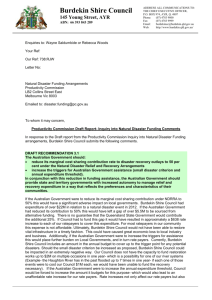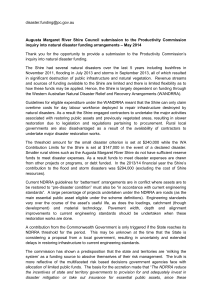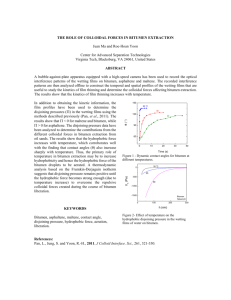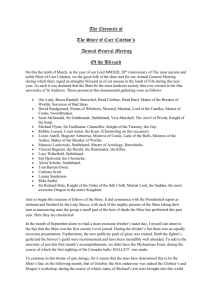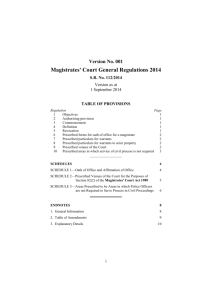Submission 11 - Burdekin Shire Council
advertisement
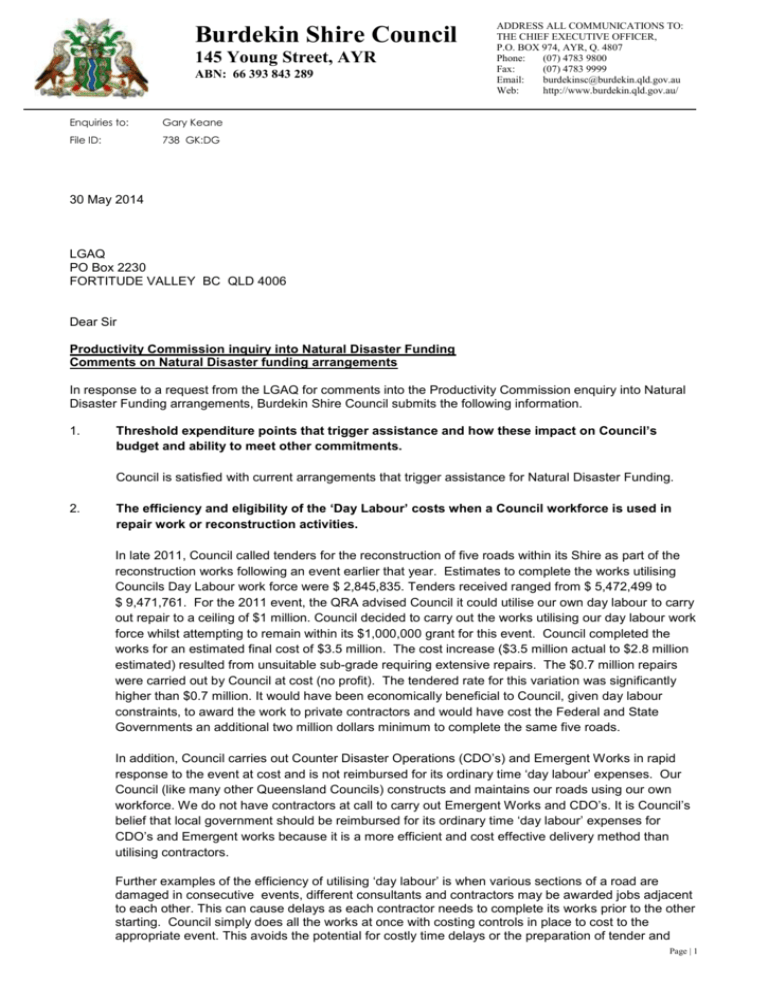
Burdekin Shire Council 145 Young Street, AYR ABN: 66 393 843 289 Enquiries to: Gary Keane File ID: 738 GK:DG ADDRESS ALL COMMUNICATIONS TO: THE CHIEF EXECUTIVE OFFICER, P.O. BOX 974, AYR, Q. 4807 Phone: (07) 4783 9800 Fax: (07) 4783 9999 Email: burdekinsc@burdekin.qld.gov.au Web: http://www.burdekin.qld.gov.au/ 30 May 2014 LGAQ PO Box 2230 FORTITUDE VALLEY BC QLD 4006 Dear Sir Productivity Commission inquiry into Natural Disaster Funding Comments on Natural Disaster funding arrangements In response to a request from the LGAQ for comments into the Productivity Commission enquiry into Natural Disaster Funding arrangements, Burdekin Shire Council submits the following information. 1. Threshold expenditure points that trigger assistance and how these impact on Council’s budget and ability to meet other commitments. Council is satisfied with current arrangements that trigger assistance for Natural Disaster Funding. 2. The efficiency and eligibility of the ‘Day Labour’ costs when a Council workforce is used in repair work or reconstruction activities. In late 2011, Council called tenders for the reconstruction of five roads within its Shire as part of the reconstruction works following an event earlier that year. Estimates to complete the works utilising Councils Day Labour work force were $ 2,845,835. Tenders received ranged from $ 5,472,499 to $ 9,471,761. For the 2011 event, the QRA advised Council it could utilise our own day labour to carry out repair to a ceiling of $1 million. Council decided to carry out the works utilising our day labour work force whilst attempting to remain within its $1,000,000 grant for this event. Council completed the works for an estimated final cost of $3.5 million. The cost increase ($3.5 million actual to $2.8 million estimated) resulted from unsuitable sub-grade requiring extensive repairs. The $0.7 million repairs were carried out by Council at cost (no profit). The tendered rate for this variation was significantly higher than $0.7 million. It would have been economically beneficial to Council, given day labour constraints, to award the work to private contractors and would have cost the Federal and State Governments an additional two million dollars minimum to complete the same five roads. In addition, Council carries out Counter Disaster Operations (CDO’s) and Emergent Works in rapid response to the event at cost and is not reimbursed for its ordinary time ‘day labour’ expenses. Our Council (like many other Queensland Councils) constructs and maintains our roads using our own workforce. We do not have contractors at call to carry out Emergent Works and CDO’s. It is Council’s belief that local government should be reimbursed for its ordinary time ‘day labour’ expenses for CDO’s and Emergent works because it is a more efficient and cost effective delivery method than utilising contractors. Further examples of the efficiency of utilising ‘day labour’ is when various sections of a road are damaged in consecutive events, different consultants and contractors may be awarded jobs adjacent to each other. This can cause delays as each contractor needs to complete its works prior to the other starting. Council simply does all the works at once with costing controls in place to cost to the appropriate event. This avoids the potential for costly time delays or the preparation of tender and Page | 1 contract documentation, calling and evaluation of tenders, and expensive mobilisation costs of contractors. Maintaining Council workforces in rural shires is an essential part of retaining critical mass in those communities and ensuring the social fabric of the townships is viable. Ayr is located 80 km from Townsville. If council contracted out its road works construction and maintenance, it is most likely that this workforce would commute from Townsville. 3. ‘Value for Money’ examples of actual savings, foregone savings, or demonstrable overall project savings from following a particular procurement method. Council seconded a senior technical officer into the role of NDRRA Manager and with his extensive local knowledge and engineering experience is responsible for the expenditure of all NDRRA funds. Fee proposals are sourced from consulting engineers as required and all contract documentation and consulting fees approved by the Manager prior to engagement. Council was previously approved an overhead of 12.5% to its works to cover survey, design and supervision fees. These fees were charged against Council completed works at cost. Where works are completed by Council under this arrangement all external plant and materials are utilised from Council’s annual tenders, thus ensuring competitive rates on plant and materials. Subsequently, Council recently received approval to carry out reconstruction works for its 2013 event under the Local Government value for money model after demonstrated savings to the Q.R.A. Council is disappointed that the Local Government Value for Money Model is unavailable as a delivery option for damage as a result of tropical Cyclone Ita April 2014 as Council is confident that for small events the Local Government Value for Money Model is the most economical and efficient method of delivery to all levels of government. 4. Projects which include betterment or natural disaster resilience. Following the 2013 Event, Council was successful in obtaining three (3) Betterment Projects. One has been completed within budget and two are currently in the design phase. The completed project allowed council to construct two larger culverts with a bitumen causeway where previously smaller culverts and a gravel road existed. Prior to the betterment project being undertaken, this section of road would suffer serious damage during every flood event. Following the completion of this betterment project, a flood earlier this year resulted in no damage to the section of road. Council has a history of carrying out complementary works at its own cost whilst carrying out NDRRA restoration works. For example, when a 4m wide bitumen road is damaged by flooding, Council will replace the 4m bitumen under NDRRA and also add another 2m of bitumen width paying for the extra width out of our own funds. The new 6m wide bitumen road has more chance of remaining serviceable after the next flood, because the extra width gives more allowance for damage along the edges without having to close the road. This improves the resilience of the community. Council has no hesitation in funding these works whilst Council does the works. Council is unlikely to pay a contractor to widen a road during the NDRRA repairs as the contractor’s rates are higher than council’s rates and the council prefers to use our own workforce to construct and maintain our roads. 5. Public infrastructure, such as parks and landscaping, that may currently be classed as ‘ineligible’’ expenditure and the impact on the capacity to complete works in line with community expectations. Councils commit substantial capital and maintenance expenditure to provide modern recreational facilities to promote and encourage healthy recreational activities. These facilities include playground equipment, skate parks, BBQ’s, covered play area, parks and swimming pools. Most of these facilities are accessed by residents at no charge. Swimming pools are provided to residents at a nominal user pays fee. Our council does not have the population base to recover enough fees from swimming pool operations to cover the cost. As such, all of the facilities mentioned previously should be recognised as an essential public asset ensuring the health of the community and assisting in the recovery of the community following natural disasters. Page | 2 6. Reinstatement of natural environment such as river banks and foreshores. Burdekin Shire Rivers Improvement Trust raised an annual budget in the vicinity of $300,000 from ratepayers for the maintenance and improvement of the river banks within the Shire. Typically funds are spent stabilising and strengthening the banks of the Burdekin and Haughton Rivers and endeavour to protect valuable farm lands and public infrastructure. Consequently such assets should be classed as essential public assets and be reinstated when damaged by natural disasters. In 2008 the trust spent $425,000 reconstructing a section of natural bank which was destroyed when the Haughton River flooded. Should this natural bank have not been repaired then substantial damage to the road and rail network and adjacent farmlands would have occurred in future floods. If left unrepaired, the next flood may have resulted in a realignment of the river path, which could have catastrophic effects on the land, infrastructure and people. As a consequence of the works, the river is maintained in its current path, as are other rivers within the shire and state due to these bank protection works. Wayne Saldumbide MANAGER OF OPERATIONS Page | 3



